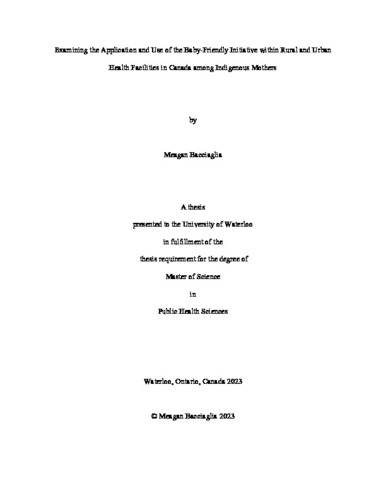UWSpace will be migrating to a new version of its software from July 29th to August 1st. UWSpace will be offline for all UW community members during this time.
Examining the Application and Use of the Baby-Friendly Initiative within Rural and Urban Health Facilities in Canada among Indigenous Mothers
Abstract
Background: To prevent infant mortality and morbidity, WHO and UNICEF established the Baby-Friendly Hospital Initiative (BFHI) to support breastfeeding initiation and duration by improving the quality of care provided in health facilities globally. Indigenous communities across the world report lower breastfeeding rates compared to non-Indigenous populations. There is very limited research surrounding the implementation of the BFI (Baby-Friendly Initiative) within Canada to support Indigenous women.
Research Questions: This study sought to answer: 1) How is the BFI implemented and utilized among health facilities that service Indigenous women in Canada? 2) What is the availability and utilization of the BFI among Indigenous women? 3) Are there differences in the uptake of the BFI between rural and urban health facilities?
Methods: Qualitative methodologies and methods, including semi-structured interviews, case study research, and document analysis were implemented to examine the experiences of policymakers, health service providers, and health organizations. Seven participants were recruited from international and national health organizations, bodies of the Canadian government, and Canadian health facilities. Inuvik Regional Hospital and Grey Nuns Hospital were reviewed as the case studies through using documentary analysis. The Interactive Theory of Breastfeeding was used to inform the study design and frame the results.
Results: A conceptual model utilizing the social-ecological framework was created to expand the Interactive Theory of Breastfeeding, and contextualize the participant experiences of implementing the BFI, decisions to breastfeed, and the cultural appropriateness of the BFI for Indigenous women. Through the adapted model, a unique contribution includes the incorporation of Indigenous traditions and context. Previous models have not specifically examined policy and environmental influences relating to breastfeeding and Indigenous women within Canada.
Conclusion: There is an opportunity for the BFI to be a culturally appropriate initiative for Indigenous mothers if the facility/health center implementing the initiative understands and incorporates the local context at a variety of levels, including interpersonal, organizational, and in the environment and policy layers. Collaborating with key stakeholders and the community is one method to understand and incorporate local context. The BFI as a stand-alone initiative is not culturally appropriate, and steps need to be completed to ensure that during implementation there is a focus on empowering women with education and informed choice in their infant feeding decisions. There are a variety of factors that influence an Indigenous women’s decision to breastfeed, and there is a need for culturally appropriate and gender inclusive educational materials, supports, and health services to be available.
Collections
Cite this version of the work
Meagan Bacciaglia
(2023).
Examining the Application and Use of the Baby-Friendly Initiative within Rural and Urban Health Facilities in Canada among Indigenous Mothers. UWSpace.
http://hdl.handle.net/10012/19124
Other formats
Related items
Showing items related by title, author, creator and subject.
-
Exploring Peel Region’s “Healthy Development Assessment” Healthy Built Environment Tool and Policy-Making Process: Critical Lessons for Future Research and Policy.
Godfrey, Nicholas (University of Waterloo, 2019-08-12)The purpose of this thesis is to contribute to the critical literature on “healthy built environment” planning policy-making. It applies the theories of post-politics and policy mobilities against a case study of Peel ... -
The Maternal Health Literacy of South Asian Newcomer Mothers and Canadian-born Mothers
Khajeei, Dahlia (University of Waterloo, 2024-01-09)Research suggests newcomer mothers score lower than Canadian-born mothers on health literacy (HL) and health numeracy (HN) assessments and have difficulty accessing maternal health services. This dissertation explored the ... -
Connecting gender and social networks to explore health service access and use in Negros Occidental, Philippines: A qualitative study
Luu, Kathy (University of Waterloo, 2021-01-25)Background: In early 2019, the Universal Health Care Bill was signed into law in the Philippines with the intention of enabling all citizens to access a comprehensive range of health care services without bearing costs. ...

